Abstract
The development of antimicrobial drugs, and particularly of antibiotics, has played a considerable role in substantially reducing the morbidity and mortality rates of many infectious diseases. However, the fact that bacteria can develop resistance to antibiotics has produced a situation where antimicrobial agents are losing their effectiveness because of the spread and persistence of drug-resistant organisms. To combat this, more and more antibiotics with increased therapeutic and prophylactic action will need to be developed.
This article is concerned with antibiotic resistance in bacteria which are pathogenic to man and animals. The historical background is given, as well as some information on the present situation and trends of antibiotic resistance to certain bacteria in different parts of the world. Considerable concern is raised over the use of antibiotics in man and animals. It is stated that antibiotic resistance in human pathogens is widely attributed to the “misuse” of antibiotics for treatment and prophylaxis in man and to the administration of antibiotics to animals for a variety of purposes (growth promotion, prophylaxis, or therapy), leading to the accumulation of resistant bacteria in their flora. Factors favouring the development of resistance are discussed.
Full text
PDF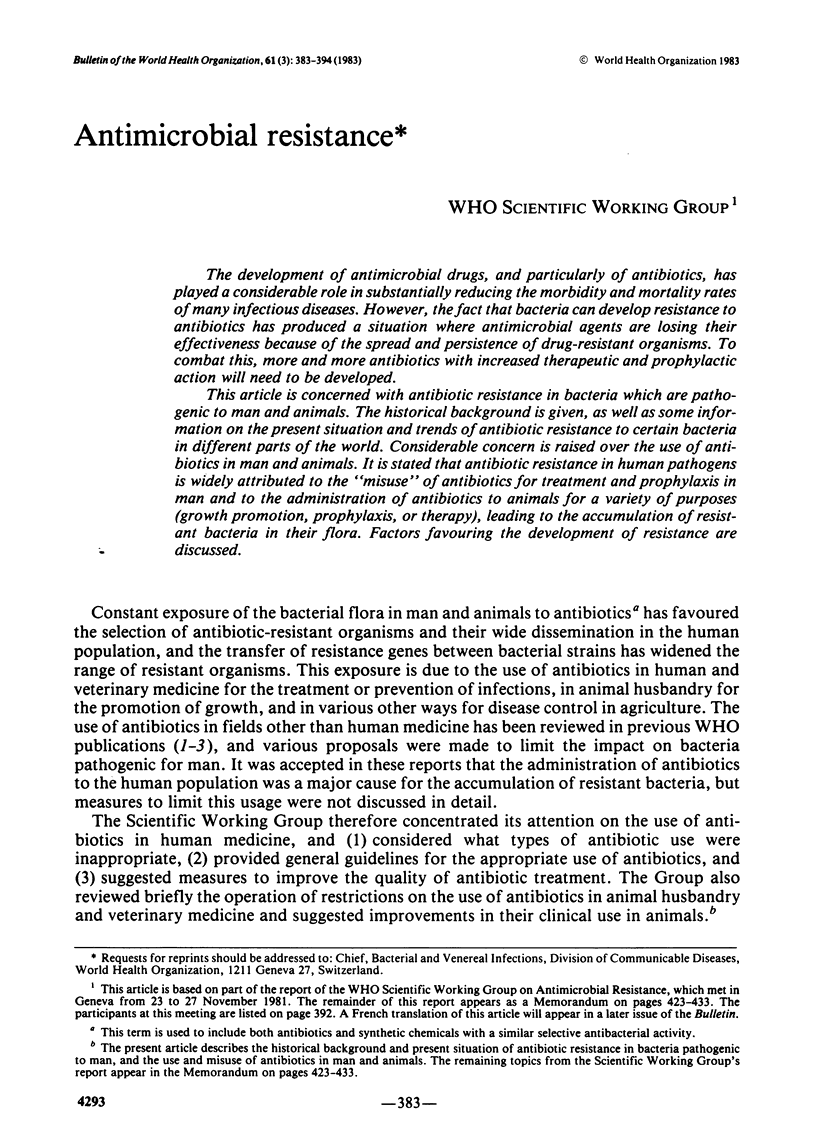
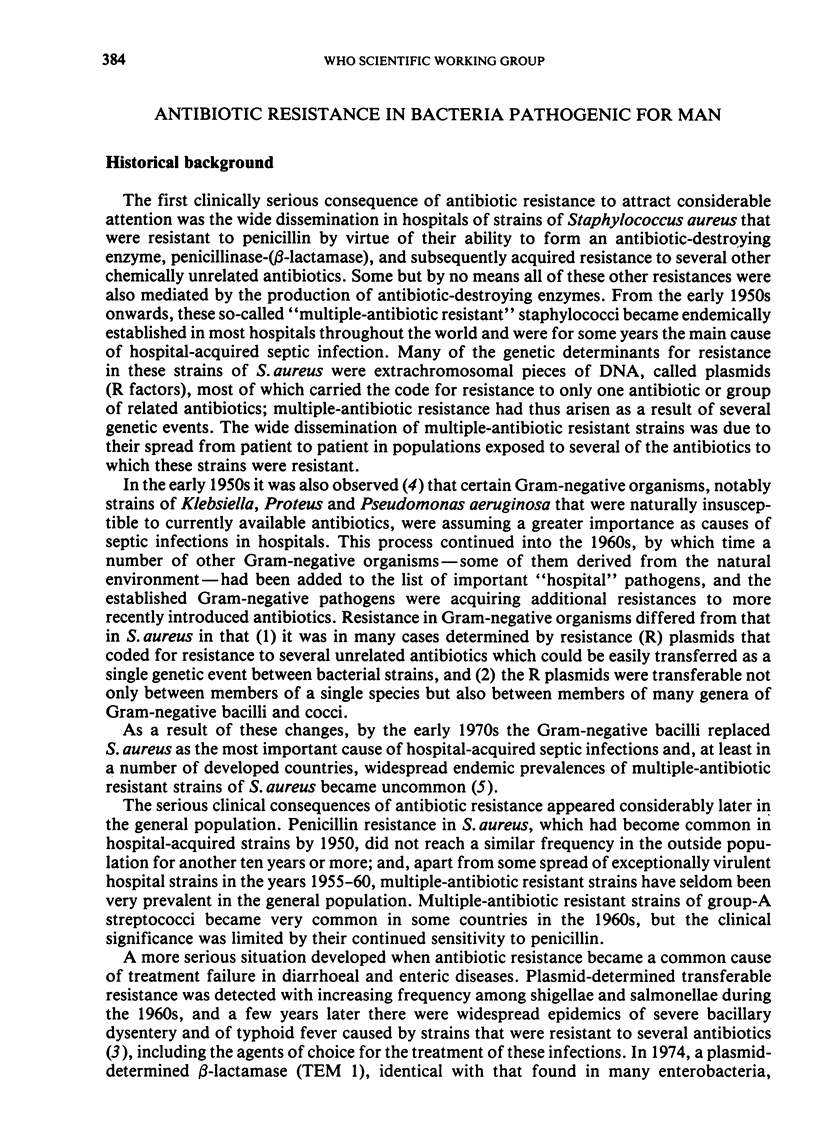
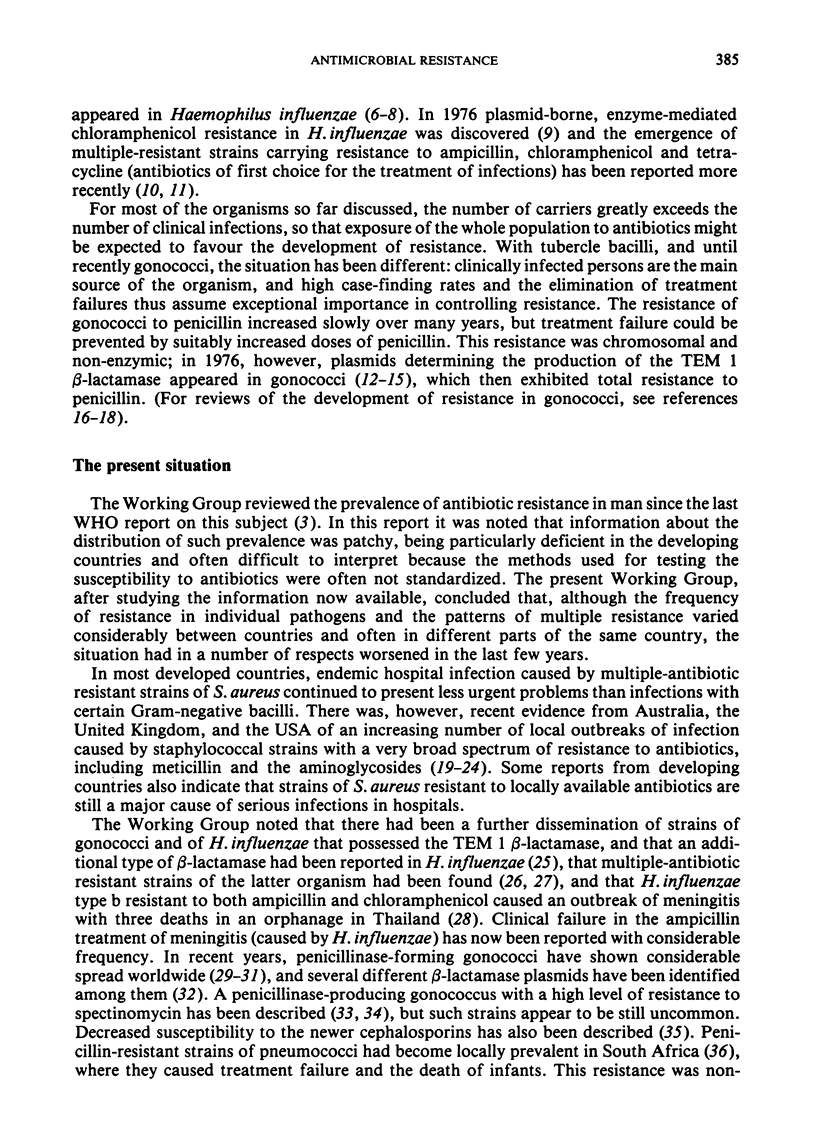
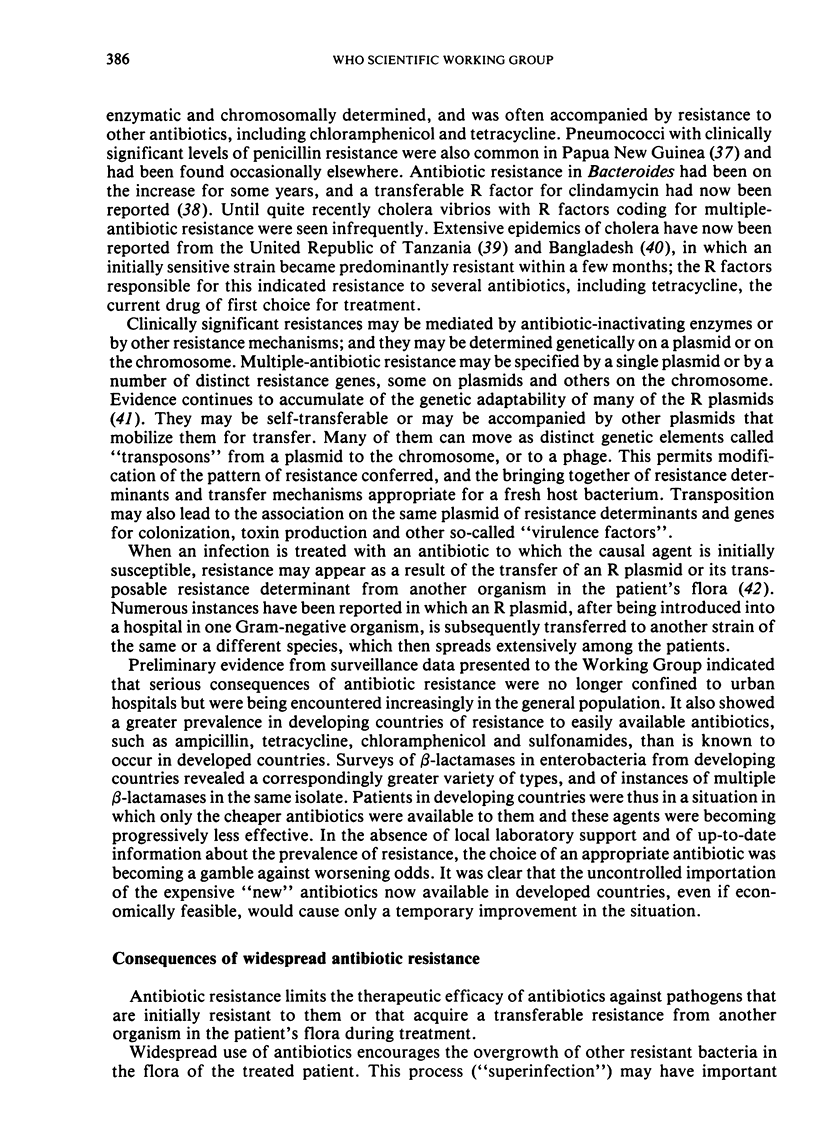
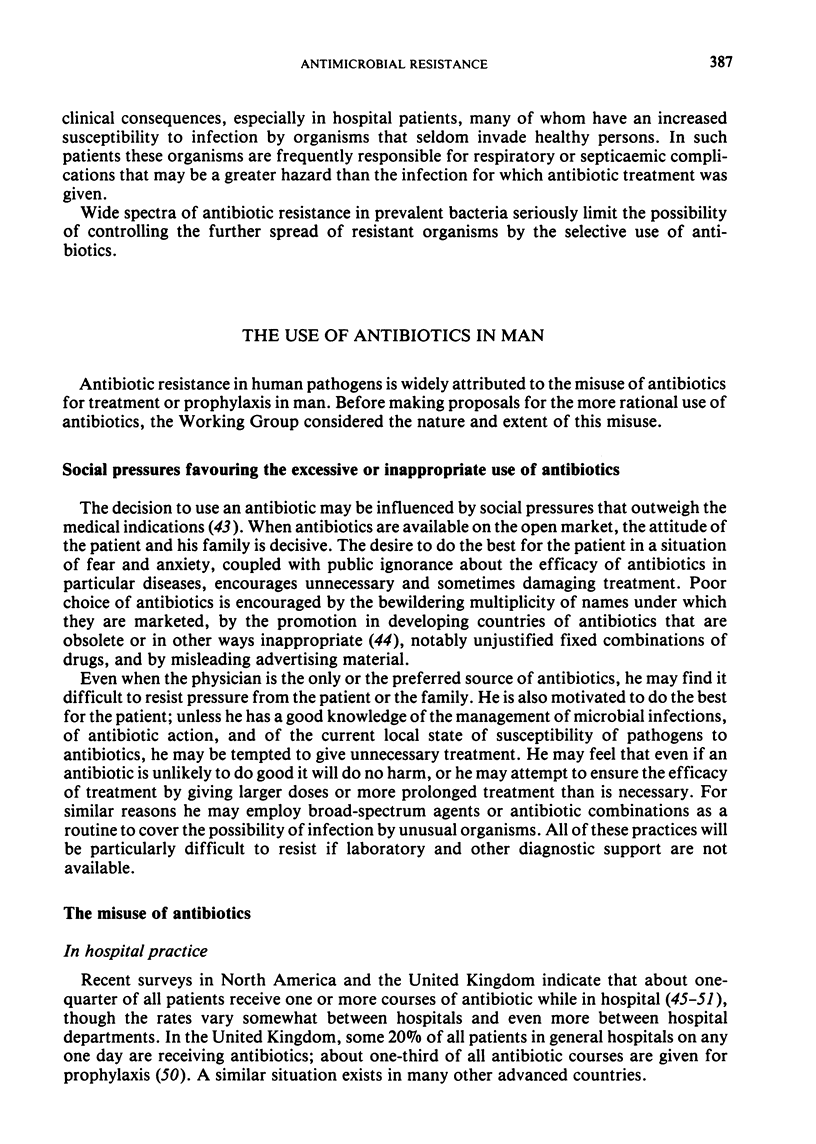
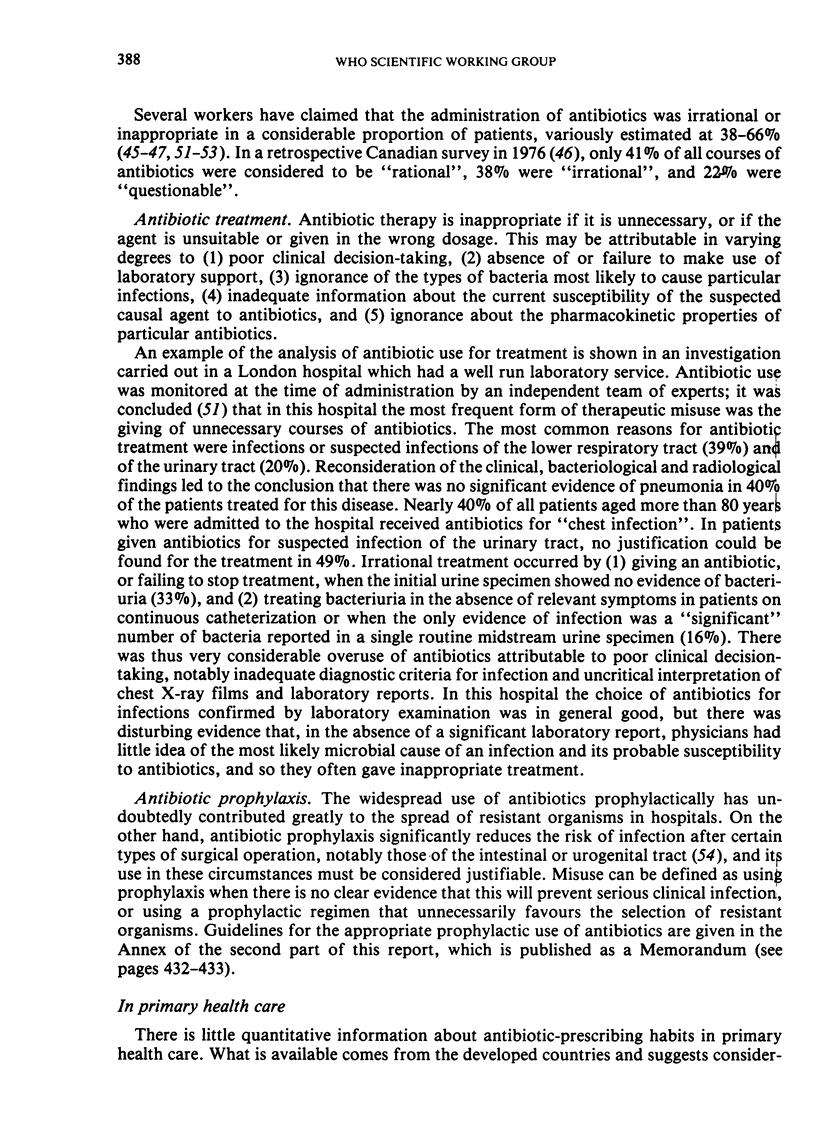
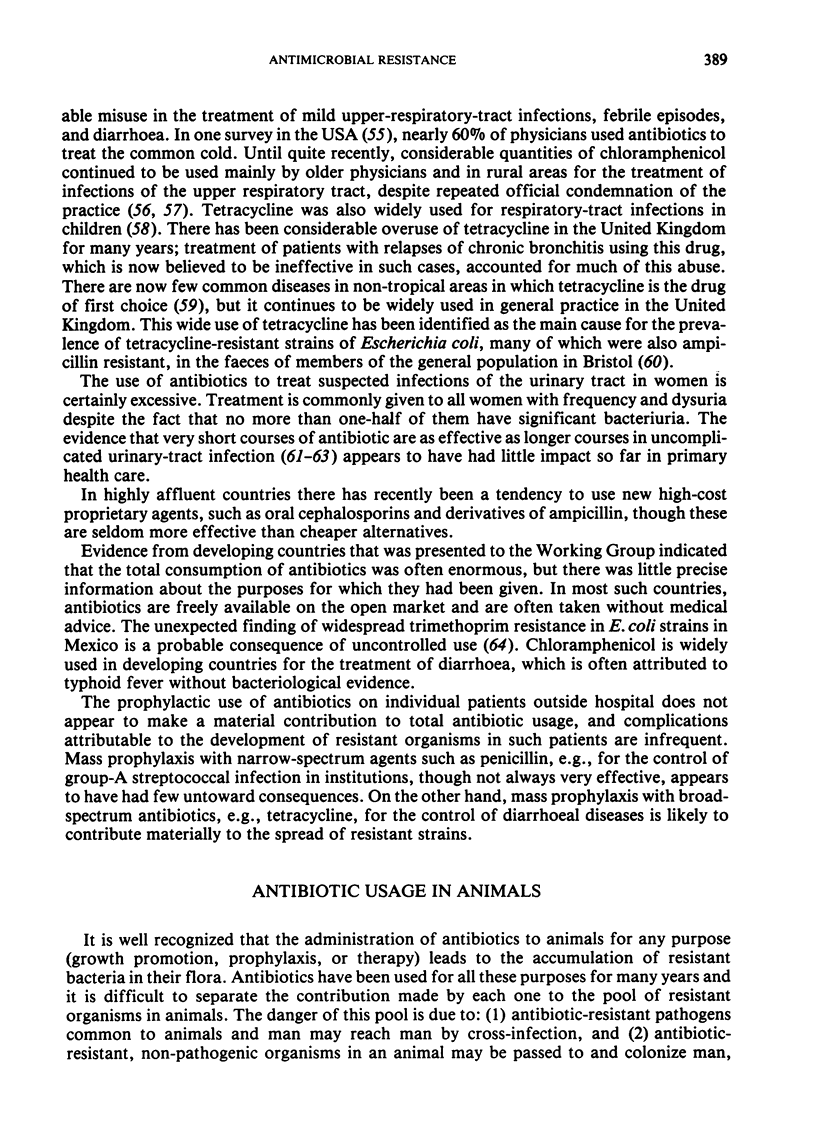
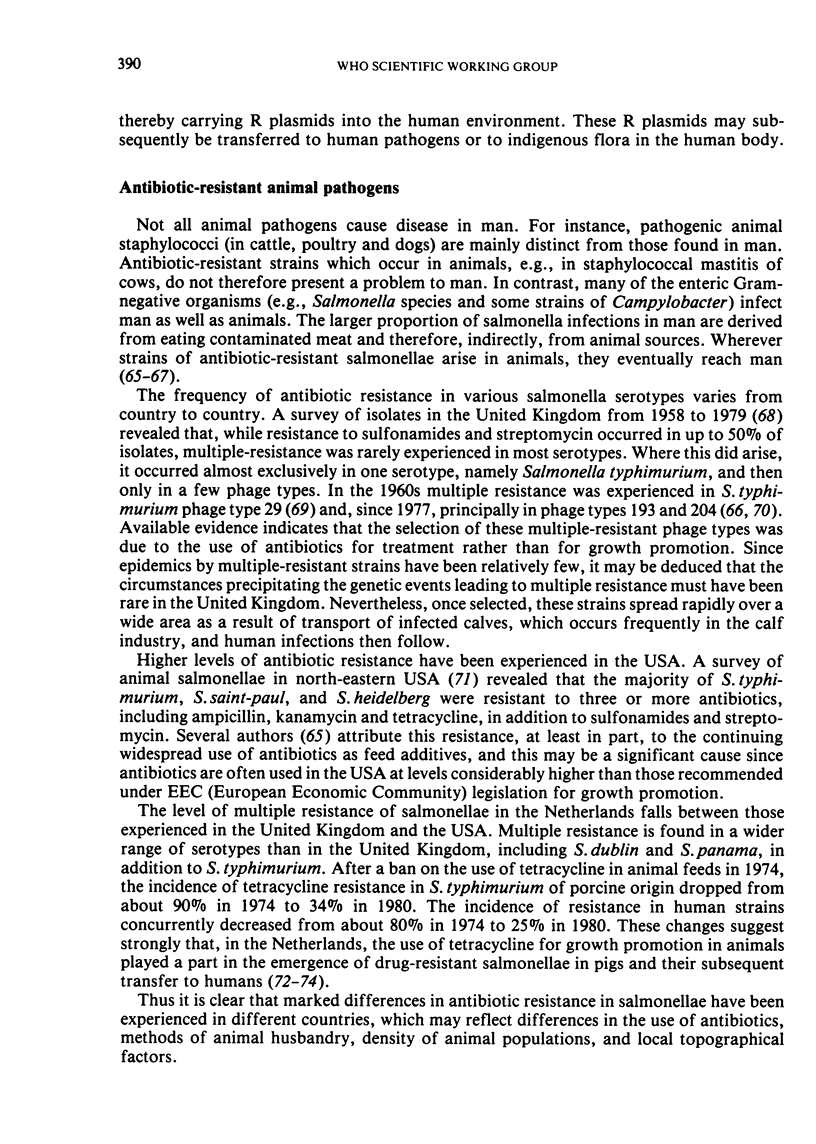
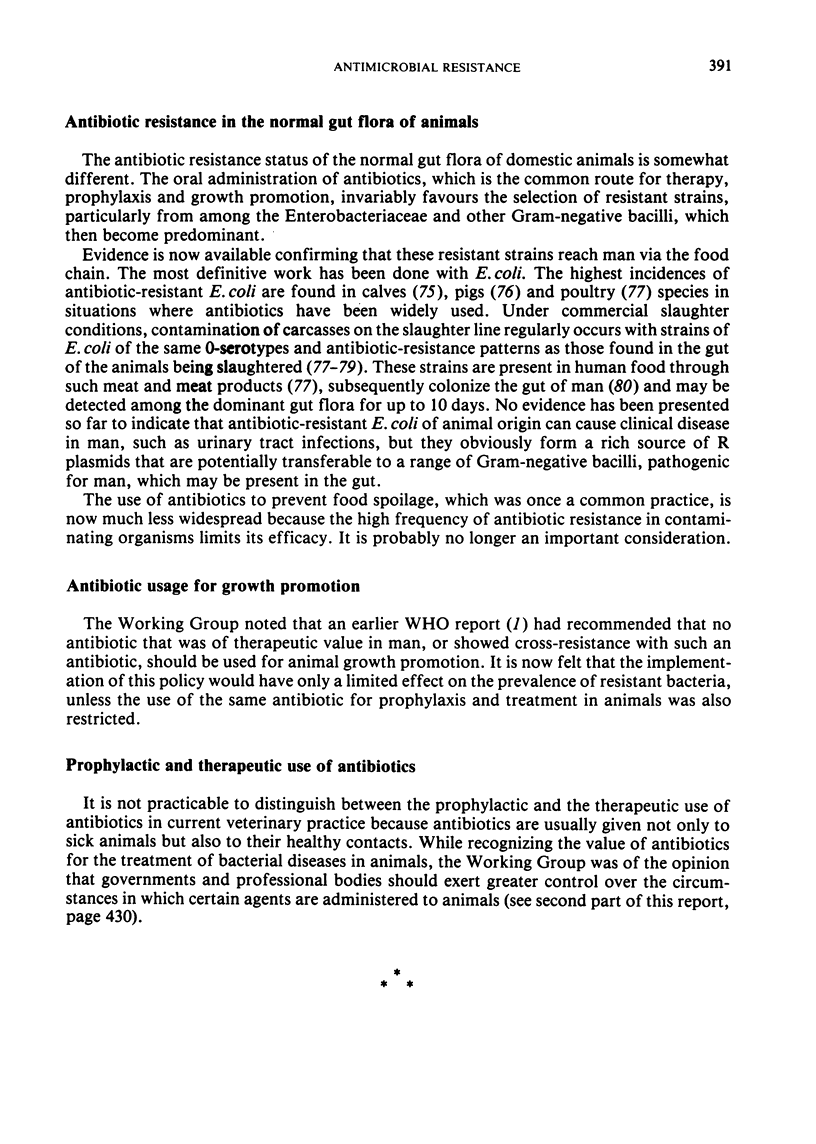
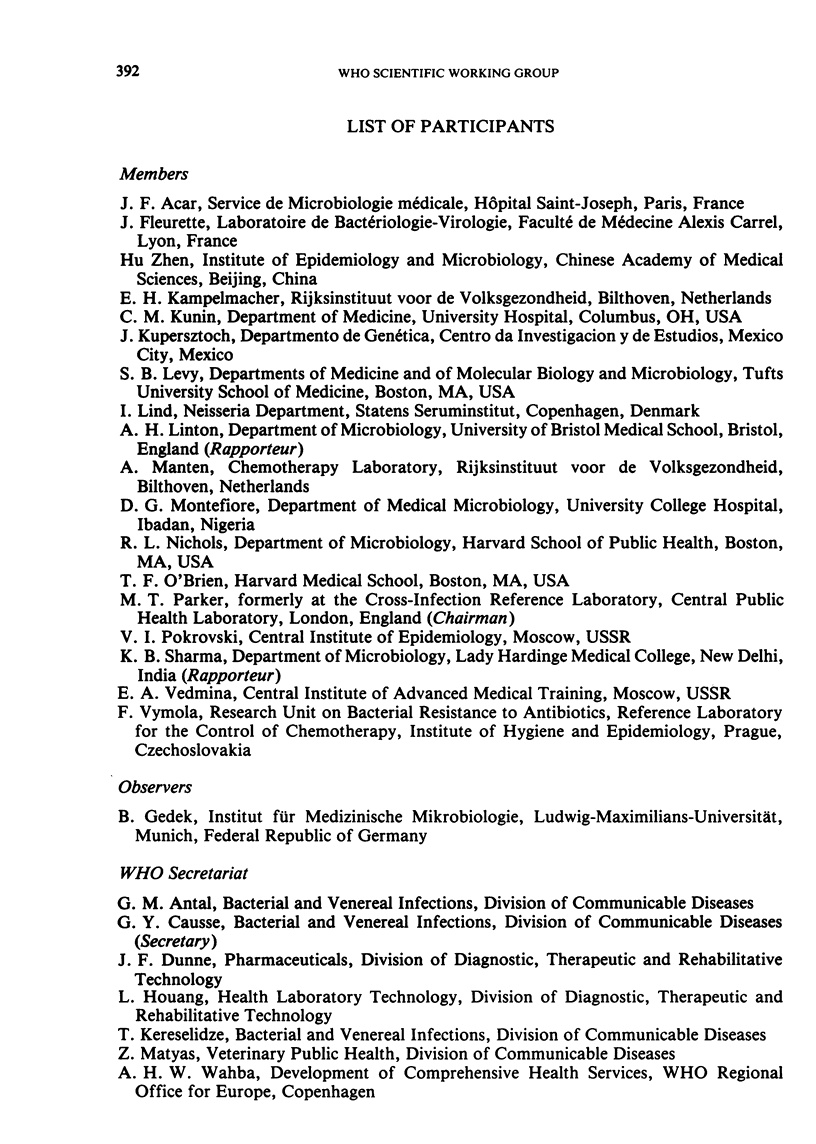
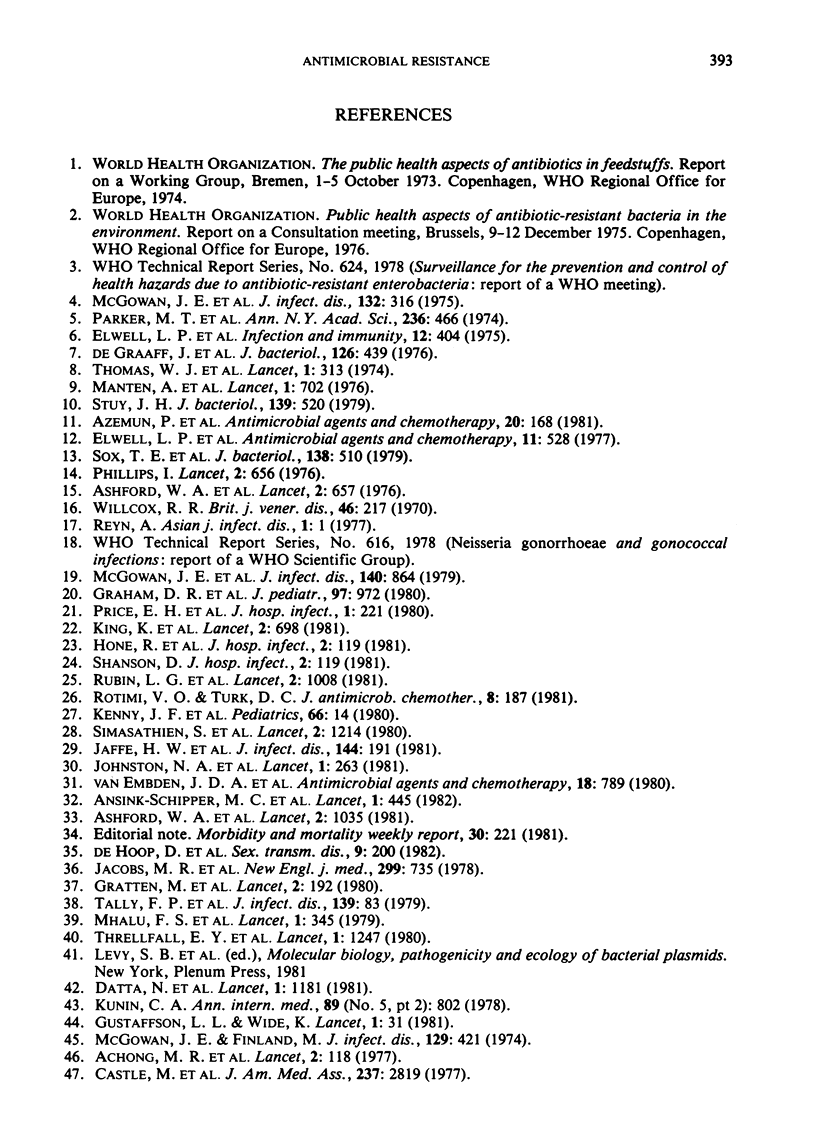
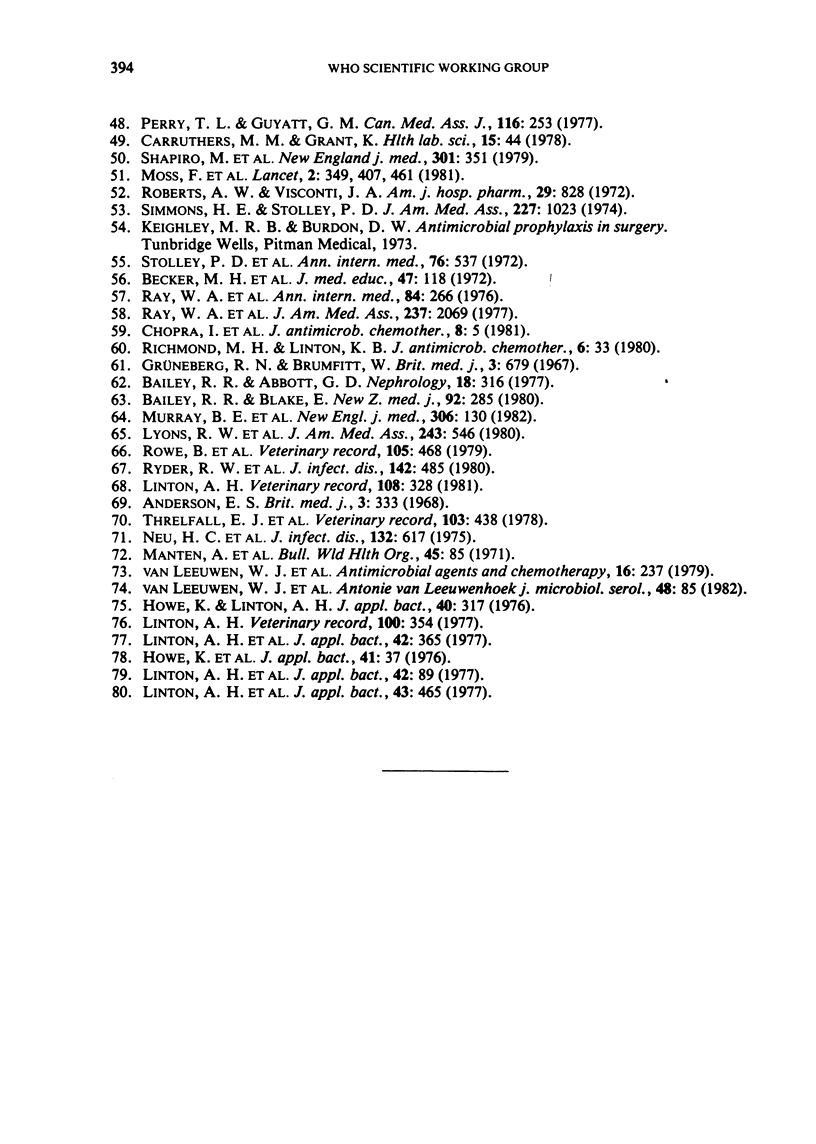
Selected References
These references are in PubMed. This may not be the complete list of references from this article.
- Ashford W. A., Golash R. G., Hemming V. G. Penicillinase-producing Neisseria gonorrhoeae. Lancet. 1976 Sep 25;2(7987):657–658. doi: 10.1016/s0140-6736(76)92467-3. [DOI] [PubMed] [Google Scholar]
- Bailey R. R., Abbott G. D. Treatment of urinary-tract infection with a single dose of amoxycillin. Nephron. 1977;18(6):316–320. doi: 10.1159/000180849. [DOI] [PubMed] [Google Scholar]
- Bailey R. R., Blake E. Treatment of uncomplicated urinary tract infections with a single dose of co-trimoxazole. N Z Med J. 1980 Oct 8;92(669):285–286. [PubMed] [Google Scholar]
- Becker M. H., Stolley P. D., Lasagna L., McEvilla J. D., Sloane L. M. Differential education concerning therapeutics and resultant physician prescribing patterns. J Med Educ. 1972 Feb;47(2):118–127. doi: 10.1097/00001888-197202000-00006. [DOI] [PubMed] [Google Scholar]
- Castle M., Wilfert C. M., Cate T. R., Osterhout S. Antibiotic use at Duke University Medical Center. JAMA. 1977 Jun 27;237(26):2819–2822. [PubMed] [Google Scholar]
- Datta N., Richards H., Datta C. Salmonella typhi in vivo acquires resistance to both chloramphenicol and co-trimoxazole. Lancet. 1981 May 30;1(8231):1181–1183. doi: 10.1016/s0140-6736(81)92350-3. [DOI] [PubMed] [Google Scholar]
- De Graaff J., Elwell L. P., Falkow S. Molecular nature of two beta-lactamase-specifying plasmids isolated from Haemophilus influenzae type b. J Bacteriol. 1976 Apr;126(1):439–446. doi: 10.1128/jb.126.1.439-446.1976. [DOI] [PMC free article] [PubMed] [Google Scholar]
- Gratten M., Naraqi S., Hansman D. High prevalence of penicillin-insensitive pneumococci in Port Moresby, Papua New Guinea. Lancet. 1980 Jul 26;2(8187):192–195. doi: 10.1016/s0140-6736(80)90072-0. [DOI] [PubMed] [Google Scholar]
- Howe K., Linton A. H. The distribution of O-antigen types of Escherichia coli in normal calves, compared with man, and their R plasmid carriage. J Appl Bacteriol. 1976 Jun;40(3):317–330. doi: 10.1111/j.1365-2672.1976.tb04180.x. [DOI] [PubMed] [Google Scholar]
- Jaffe H. W., Biddle J. W., Johnson S. R., Wiesner P. J. Infections due to penicillinase-producing Neisseria gonorrhoeae in the United States: 1976-1980. J Infect Dis. 1981 Aug;144(2):191–197. doi: 10.1093/infdis/144.2.191. [DOI] [PubMed] [Google Scholar]
- Johnston N. A., Kolator B., Seth A. D. A survey of beta-lactamase-producing gonococcal isolates reported in the United Kingdom 1979--80. The present trend. Lancet. 1981 Jan 31;1(8214):263–264. doi: 10.1016/s0140-6736(81)92096-1. [DOI] [PubMed] [Google Scholar]
- Kunin C. M. Problem of antibiotic usage. Definitions, causes, and proposed solutions. Ann Intern Med. 1978 Nov;89(5 Pt 2 Suppl):802–805. doi: 10.7326/0003-4819-89-5-802. [DOI] [PubMed] [Google Scholar]
- Linton A. H., Howe K., Bennett P. M., Richmond M. H., Whiteside E. J. The colonization of the human gut by antibiotic resistant Escherichia coli from chickens. J Appl Bacteriol. 1977 Dec;43(3):465–469. doi: 10.1111/j.1365-2672.1977.tb00773.x. [DOI] [PubMed] [Google Scholar]
- McGowan J. E., Jr, Barnes M. W., Finland M. Bacteremia at Boston City Hospital: Occurrence and mortality during 12 selected years (1935-1972), with special reference to hospital-acquired cases. J Infect Dis. 1975 Sep;132(3):316–335. doi: 10.1093/infdis/132.3.316. [DOI] [PubMed] [Google Scholar]
- McGowan J. E., Jr, Finland M. Infection and antibiotic usage at Boston City Hospital: changes in prevalence during the decade 1964-1973. J Infect Dis. 1974 Apr;129(4):421–428. doi: 10.1093/infdis/129.4.421. [DOI] [PubMed] [Google Scholar]
- McGowan J. E., Jr, Terry P. M., Huang T. S., Houk C. L., Davies J. Nosocomial infections with gentamicin-resistant Staphylococcus aureus: plamid analysis as an epidemiologic tool. J Infect Dis. 1979 Dec;140(6):864–872. doi: 10.1093/infdis/140.6.864. [DOI] [PubMed] [Google Scholar]
- Mhalu F. S., Mmari P. W., Ijumba J. Rapid emergence of El Tor Vibrio cholerae resistant to antimicrobial agents during first six months of fourth cholera epidemic in Tanzania. Lancet. 1979 Feb 17;1(8112):345–347. doi: 10.1016/s0140-6736(79)92889-7. [DOI] [PubMed] [Google Scholar]
- Murray B. E., Rensimer E. R., DuPont H. L. Emergence of high-level trimethoprim resistance in fecal Escherichia coli during oral administration of trimethoprim or trimethoprim--sulfamethoxazole. N Engl J Med. 1982 Jan 21;306(3):130–135. doi: 10.1056/NEJM198201213060302. [DOI] [PubMed] [Google Scholar]
- Neu H. C., Cherubin C. E., Longo E. D., Flouton B., Winter J. Antimicrobial resistance and R-factor transfer among isolates of Salmonella in the northeastern United States: a comparison of human and animal isolates. J Infect Dis. 1975 Dec;132(6):617–622. doi: 10.1093/infdis/132.6.617. [DOI] [PubMed] [Google Scholar]
- Parker M. T., Asheshov E. H., Hewitt J. H., Nakhla L. S., Brock B. M. Endemic staphylococcal infections in hospitals. Ann N Y Acad Sci. 1974 Jul 31;236(0):466–484. doi: 10.1111/j.1749-6632.1974.tb41511.x. [DOI] [PubMed] [Google Scholar]
- Perry T. L., Guyatt G. H. Antimicrobial drug use in three Canadian general hospitals. Can Med Assoc J. 1977 Feb 5;116(3):253–256. [PMC free article] [PubMed] [Google Scholar]
- Phillips I. Beta-lactamase-producing, penicillin-resistant gonococcus. Lancet. 1976 Sep 25;2(7987):656–657. doi: 10.1016/s0140-6736(76)92466-1. [DOI] [PubMed] [Google Scholar]
- Ray W. A., Federspiel C. F., Schaffner W. Prescribing of chloramphenicol in ambulatory practice. An epidemiologic study among Tennessee Medicaid recipients. Ann Intern Med. 1976 Mar;84(3):266–270. doi: 10.7326/0003-4819-84-3-266. [DOI] [PubMed] [Google Scholar]
- Ray W. A., Federspiel C. F., Schaffner W. Prescribing of tetracycline to children less than 8 years old. A two-year epidemiologic study among ambulatory Tennessee medicaid recipients. JAMA. 1977 May 9;237(19):2069–2074. [PubMed] [Google Scholar]
- Roberts A. W., Visconti J. A. The rational and irrational use of systemic antimicrobial drugs. Am J Hosp Pharm. 1972 Oct;29(10):828–834. [PubMed] [Google Scholar]
- Rotimi V. O., Turk D. C. Transferable multiple antibiotic resistance in Haemophilus influenzae. J Antimicrob Chemother. 1981 Sep;8(3):187–192. doi: 10.1093/jac/8.3.187. [DOI] [PubMed] [Google Scholar]
- Ryder R. W., Blake P. A., Murlin A. C., Carter G. P., Pollard R. A., Merson M. H., Allen S. D., Brenner D. J. Increase in antibiotic resistance among isolates of Salmonella in the United States, 1967-1975. J Infect Dis. 1980 Oct;142(4):485–491. doi: 10.1093/infdis/142.4.485. [DOI] [PubMed] [Google Scholar]
- Simasathien S., Duangmani C., Echeverria P. Haemophilus influenzae type B resistant to ampicillin and chloramphenicol in an orphanage in Thailand. Lancet. 1980 Dec 6;2(8206):1214–1217. doi: 10.1016/s0140-6736(80)92478-2. [DOI] [PubMed] [Google Scholar]
- Simmons H. E., Stolley P. D. This is medical progress? Trends and consequences of antibiotic use in the United States. JAMA. 1974 Mar 4;227(9):1023–1028. doi: 10.1001/jama.227.9.1023. [DOI] [PubMed] [Google Scholar]
- Sox T. E., Mohammed W., Sparling P. F. Transformation-derived Neisseria gonorrhoeae plasmids with altered structure and function. J Bacteriol. 1979 May;138(2):510–518. doi: 10.1128/jb.138.2.510-518.1979. [DOI] [PMC free article] [PubMed] [Google Scholar]
- Stolley P. D., Becker M. H., McEvilla J. D., Lasagna L., Gainor M., Sloane L. M. Drug prescribing and use in an American community. Ann Intern Med. 1972 Apr;76(4):537–540. doi: 10.7326/0003-4819-76-4-537. [DOI] [PubMed] [Google Scholar]
- Stuy J. H. Plasmid transfer in Haemophilus influenzae. J Bacteriol. 1979 Aug;139(2):520–529. doi: 10.1128/jb.139.2.520-529.1979. [DOI] [PMC free article] [PubMed] [Google Scholar]
- Willcox R. R. A survey of problems in the antibiotic treatment of gonorrhoea. With special reference to South-East Asia. Br J Vener Dis. 1970 Jun;46(3):217–242. doi: 10.1136/sti.46.3.217. [DOI] [PMC free article] [PubMed] [Google Scholar]
- de Hoop D., Nayyar K. C., van Klingeren B., Stolz E., Michel M. F. Infections with non-penicillinase-producing Neisseria gonorrhoeae treated with cefuroxime: treatment failures. Sex Transm Dis. 1982 Oct-Dec;9(4):200–201. doi: 10.1097/00007435-198210000-00007. [DOI] [PubMed] [Google Scholar]


